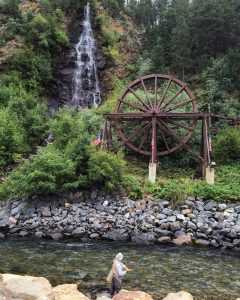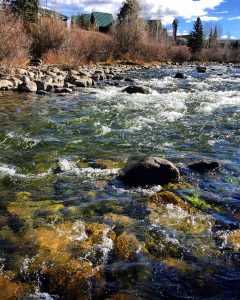WANDERLUST
Every month, almost a million vehicles travel the 100 miles on Interstate 70 between Denver and Vail, Colorado. They zoom past gorgeous Rocky Mountain scenery at speeds up to 75 mph, burrow through the highest auto tunnel in North America, and switch back their way over the two-mile-high Vail Pass.
But those in the know, slow down and stop in four delightful and historic towns along the way. The Interstate highway bypasses these villages with nothing but a sign, but if you take time to visit, you’ll discover an operating steam locomotive that still chugs over a 100-foot-high trestle, old gold mines and gold mills, hundreds of historic Victorian buildings, tranquil river walks, zip lines that hurl you off a cliff, breweries, fine dining, river rafting through sheer canyon walls and some of best riverside shopping in Colorado.
But be careful. With all the delights along the way, you may never make it to Vail. Heading from Denver, here’s where to make a detour.
Idaho Springs (Mile Marker 240): Adrenaline Capital of the Front Range

This is the first real mountain town from Denver, and because of that, it’s become the Mile High City’s adrenaline capital. You can jump off rock cliffs on terrifying zip lines or scream through rapids in Clear Creek Canyon. Clear Creek offers more rapids per mile than any other commercially rafted river in Colorado. There are a staggering 18 companies in town offering wet suits and rafting trips. You can rent ATVs, horses or mountain bikes and explore dozens of trails, one of which is affectionately called the “Oh My God Road!” You’ll find out why when you see the drop-offs without guard rails.
Colorado’s first major gold strike was discovered here and today the town’s historic main street is lined with Victorian buildings that have been converted to bars, breweries, restaurants and mountain gift shops. Beau Jo’s Pizza is a town institution. For more than 40 years, they’ve been dishing out a hearty pie of what they call “Colorado style” pizza, which means each one weighs three to five pounds. Go mountain climbing before you eat the pizza. Down the block, the Buffalo Bar is where to stop for Colorado buffalo or lamb burgers. Buffalo is the leanest of red meats and has less calories than chicken. It’s also the home to the new and stylish Westbound & Down Brewery. Try a CPA (a Colorado Pale Ale).

At the other end of Main Street, Tommyknockers Brewery has been turning out award-winning brews for 20 years, including winning 17 medals at Denver’s prestigious Great American Beer Festival.
Tommyknockers were mythical two-foot-high creatures who lived in mines and caused mischief. If you have the nerve, you can enter the real Phoenix Gold Mine, a place that looks straight out of a “Lone Ranger” movie. Put on a hard hat and follow a vein of gold through a twisting, dark and damp tunnel, just hoping that the creaking 100-year-old wood beams hold up for at least one more hour.

Right in town, the Argo Gold Mill processed more than $100 million of gold in its day. Today, it’s a steampunk’s dream of mining equipment, shafts, belts, wood ladders and stairs. After the tour, they’ll teach you the fine art of gold panning. For more information visit www.clearcreekcounty.org.
Georgetown (mile marker 228): The Silver Queen
When John Denver was looking for the most picturesque town in Colorado for his holiday film, “The Christmas Gift,” he picked Georgetown. Ironically, millions of people zoom by this pretty village on I-70, or just stop at the gas stations at the exit, never knowing that just a mile away there are 200 Victorian buildings and one of the United States’ most beautiful main streets.
It was silver that made the Georgetown rich and led to elaborate mansions and beautiful homes painted in a rainbow of colors. But it was the still-standing steeples here and there that preserved the town. Not the churches.
The steeples are the remnants of volunteer fire companies, of which Georgetown had the best in Colorado. Most mountain mining towns were made of wood and burned to the ground at one point or another. Georgetown never had a major fire, and so the gorgeous main street and dozens of homes were all preserved and today, along with neighboring Silver Plume, are part of a National Historic District.
There are Western book stores, rock shops, railroad stores, galleries, Native American artwork, cute little restaurants — and of course, the Western staple — saloons. But the most fun is to walk or bike the backstreets, past one colorful Victorian home after another. You can tour the 1867 Hamill House, the home of a former Colorado governor, or stop in to see the Hotel de Paris, one of the West’s most opulent hotels that served French champagne and oysters in the 1870s.

Of all the railroad engineering feats in Colorado, one of the greatest — and scariest — is the Devil’s Gate Bridge, the 100-foot-high narrow trestle that allowed the railroad to corkscrew around and literally crossover itself, just like a Lionel toy train set, climbing 600 feet in elevation in just four miles. The feat became known as the Georgetown Loop, and today it offers a short — but thrilling — steam locomotive ride to Silver Plume, once a booming mining metropolis, but now more of a ghost town with dirt streets and old and empty false front buildings.
The steam train sends huge plumes of smoke 100 feet in the air as it chugs up the steep climb though stands of aspen, sending people scurrying from side-to-side of the open gondola cars for photos of the ever-changing scenery. The train lets go with a whistle every time it crosses the stream, and that’s the moment to have your video going. The sound of that whistle echoing off the mountains will be one that haunts you for a long time.
Silverthorne (Mile Marker 205): A River Runs Through It

Few places have changed more than Silverthorne. Before 1967, there was nothing here but a gas station and a makeshift construction camp for workers building Dillon Dam. Today, Silverthorne will celebrate its 50th anniversary in 2017 as a town that has now grown to 4,000 souls and offers one of the most beautiful shopping experiences in the nation — the Outlets at Silverthorne. But it’s the setting that makes it special. The shopping is split into three villages on both sides of the meandering Blue River, which flows right through the center of Silverthorne. Bridges connect the shopping villages, which also have underpasses beneath the roads.
You can continue on the paved bike and walking trail beside the Blue River for miles, passing upscale restaurants near the river bank like Sauce on the Blue, which offers Old World Italian cuisine alongside New York-style pizza, all with 80 wines and big picture windows and an outdoor patio overlooking the river.

Continuing along the Blue River will bring you to what will be the new Silverthorne Performing Arts Center, a cultural epicenter for all of Summit County. The new space will have two theaters for concerts, Broadway shows, lectures and other events, as well as an outdoor space that can be used for summer concerts. Not only is the river beautiful, it is designated as a Gold Medallion Fishing Stream, a honor reserved for only a few of the thousands of miles of waterways in Colorado.
Just down the road, past a field of grazing yaks, is Summit Sky Ranch, a new 21st century development of 240 single-family homes designed to fit into the landscape, rather than altering the landscape to accommodate the architecture. Unique to the area, this will be a “dark sky community,” with lower light levels so as to make it easier to see the stars that blanket the Rocky Mountain sky above. A state-of-the-art observatory will have a 20-inch refactor telescope that can be enjoyed by all through live stream to the Aspen House community center. The Blue River Valley of Silverthorne has very little ambient light, which is one way of saying, there’s nothing out here but mountains. It can be dark, which makes the night sky all that more amazing.

Ironically in Colorado, which was filled with gold and silver mines, Silverthorne’s name has nothing to do with the shiny metal. It was named after a local, Judge Marshall Silverthorn. Someone added the “e” along the way.
Frisco (Mile Marker 201)
Frisco was founded in 1870, so it’s been around a lot longer than Silverthorne. Sort of. Though it was a mining town and in its heyday had two railroads, a slew of saloons, shops and hotels, the depression hit Frisco hard. By 1930, there were only 18 people left in town. Frisco didn’t even get indoor plumbing until 1950. But then in the 1960s, Colorado’s ski industry was born with Vail, Breckenridge, Keystone and Copper Mountain all just a short drive away. The former Ghost Town of Frisco boomed again with white gold.

Today, there are 2,800 full-time residents and 34 bars and restaurants. From I-70, Frisco looks like a uninviting roadside collection of box stores and fast food, but if you get off the highway and drive a mile to the historic downtown, you’ll be rewarded with one of the prettiest and most historic main streets in Colorado. The Frisco Historic Park has relocated a dozen buildings, including an old jail, schoolhouse, ranch house, trapper’s cabin, chapel and others, and built them into a beautiful park on Main Street surrounded by Aspen trees. Don’t miss the model railroad of Frisco in the 1800s; you can run the tiny engine and cars around the miniature village for a quarter.
Across the street, Prosit is a Bavarian beer hall with 30 European beers and a slew of sausages, including pheasant, buffalo, elk and wild boar, all with sauerkraut, shredded cheese, peppers and every type of mustard. Backcountry Brewery has an outdoor beer garden, while Bread + Salt is the town’s casual breakfast place, surrounded by aspens and flower boxes.

Frisco’s main attraction these days is the Frisco Marina, which sits on the shores of 3,300-acre Lake Dillon. There are 25 miles of shoreline surrounded by mountain views, as well kayak and paddleboat rentals, sailboat regattas, boat tours, paddle boards, canoes, fishing pole rentals, sailing lessons and waterside dining. Or rent a bike and pedal around the lake on paved, off-road trails. Of course, the lake sits at 9,000 feet above sea level, so the sailing season is short: early June to mid-September. When the snow starts (which can be mid-September!) Frisco’s Adventure Park, and the Nordic Center have multi-lane tubing hills, with a lift to take you and your tube back up the mountain. There’s cross-country skiing, snowshoeing and skating.
And, of course, if you’re really desperate to get to Vail, it’s just 30 minutes farther on down the highway.
THE NEWS










